
Coal power's carbon savior could double its water woes
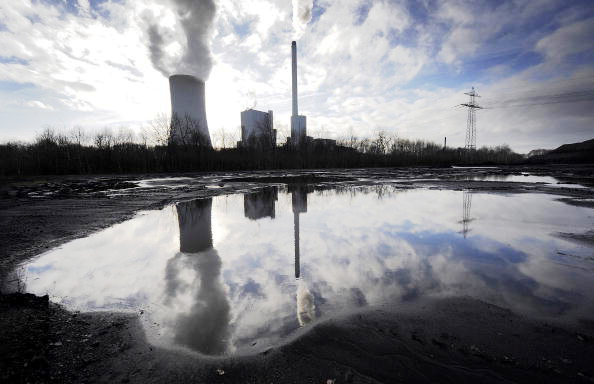
Photo: Volker Hartmann/AFP/Getty Images BY Samuel K. Moore // June 2010
NOTE: this article originally apeared in the IEEE Spectrum Magazine online edition. One of our founders is a long-time member of IEEE and we gratefully acknowledge their publication of this article.
Despite all the talk of moving to greener energy sources, coal will be with us for the foreseeable future. But if we’re really serious about cutting carbon dioxide emissions, coal plants everywhere will need to substantially reduce the billions of metric tons of CO2 they annually emit into the atmosphere. The big hope is that in the next few years the plants will begin capturing and storing a large portion of that CO2 deep underground, in the oceans, or in mineral form.
But the technology needed to capture carbon has a huge downside: It could nearly double the amount of water a plant uses for every kilowatt of electricity it delivers—easily erasing any gains from techniques aimed at conserving water and reducing thermal pollution.
"This technology was not developed in a water-constrained environment," says Jared Ciferno, technology manager for the existing plants program of the National Energy Technology Laboratory (NETL). "The bottom line is that [carbon] capture takes energy, and that translates to additional water use."
Just how much water is pretty shocking. By 2030, the addition of carbon-capture technology would boost water consumption in the U.S. electricity sector by 80 percent, or about 7500 megaliters per day, according to research at NETL, which is operated by the U.S. Department of Energy. For plants in water-stressed areas, that’s a deal breaker. "It is not likely that there is enough water supply available to any of our plants to allow for double the water use," says John Coggins, manager of resource planning at Salt River Project, a water and energy utility in Arizona.
The 80 percent figure assumes that the electricity generation lost to powering the carbon-capture system is made up for by adding more water-cooled coal-fired power. In other words, for a 550-megawatt plant to both capture its carbon and still deliver 550 MW of electricity, it would need to add more than 125 MW of additional generating capability to cover the energy used in capture. If you don’t make up for the lost generation, or make it up in some way that requires no water and emits no carbon—with a wind farm, say—the additional water consumption is more like 40 to 50 percent, according to NETL’s Ciferno.
That’s still a lot of water. For coal power plants, the state-of-the-art carbon-capture technology is known as amine-based wet scrubbing [see "Catching Carbon," above]. It’s basically the technology that puts the fizz in your Fanta. First, the plant’s flue gas is scrubbed of sulfurous nasties; what’s left is a mixture of nitrogen, water vapor, and CO2. An amine solution then reacts with the CO2, yielding a gas stream of mostly nitrogen, which goes out the smokestack, and a CO2-rich amine solution. The solution is heated to strip the CO2 from the amines. The CO2 is then cooled and compressed for storage, and the amines cycle back to pick up more CO2.
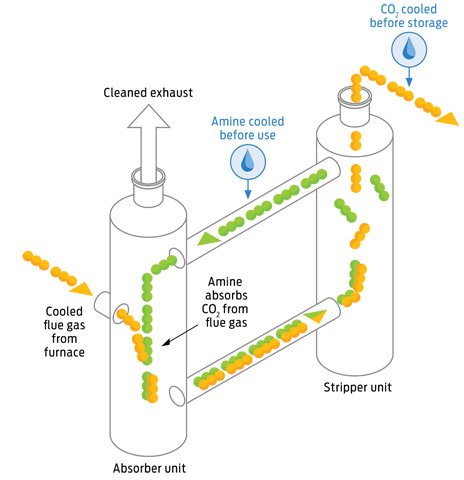
Illustration: Emily Cooper
Catching Carbon: Today’s technology uses chemicals called amines to capture carbon dioxide. Water is used to cool the amines and help compress the captured CO2.
Why does this process demand so much water? It’s all about the cooling. The power plant’s cooling tower carries heat away by evaporating water. Cooling the amines for CO2 absorption—which generates heat in itself—leads to an additional load on the cooling tower, causing more water to be lost. And compressing the CO2 to the supercritical conditions needed for storage requires cooling, too.
—————————————————————————————————–
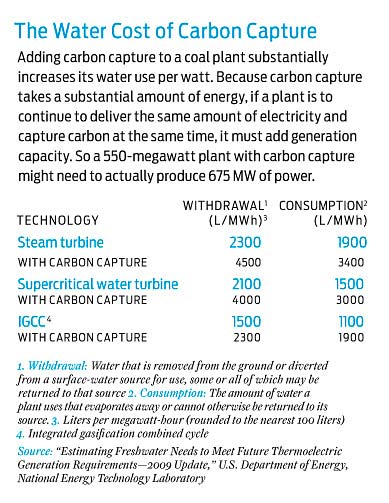
——————————————————————————————————
To really reduce CO2 emissions, says Ciferno, less thirsty forms of carbon capture will have to be developed. His lab is now focused on reducing the amount of energy involved, betting that this will take care of carbon capture’s water woes, too. With a budget of about US $50 million per year and 40 projects, NETL has perhaps the biggest R&D program in this area. The goal is commercial-scale technology by 2020 that can capture 90 percent of a coal plant’s CO2 while increasing the cost of generating electricity at that plant by less than 35 percent.
Industrial firms already have several pilot projects capturing small streams of CO2 at plants in Europe and the United States. However, none have yet been scaled up to the size that would make a noticeable difference in a plant’s water consumption. France’s Alstom Power, for one, uses chilled ammonia instead of amines, which the technology company says should be more energy and water efficient. Alstom tested the process last year with a 20-MW pilot plant at American Electric Power’s New Haven, W.Va., generating station. AEP now plans to use it to capture carbon from 235 MW of the New Haven plant’s 1300-MW capacity, starting in 2015.
Germany’s Siemens Energy has also developed an alternative technology, which relies on amino-acid salts instead of amines. Amino-acid salts pick up more carbon than amines do, so you need to pump and cool less material, says Tony DoVale, president of Siemens Environmental Systems and Services. So far the process has been demonstrated to capture carbon while leaching only 9 percent of a plant’s power, compared to amine technology’s typical 20 percent. That "would ultimately imply half the cooling load," says DoVale.
Of course, unless plant operators are compelled to capture carbon, these energy and water costs won’t be borne at all. "Why would you put on a piece of equipment that puts 10 percent of a plant’s output away if you didn’t have to?" says DoVale.
Carbon capture consumes extra energy to operate, reducing a plant's output and requiring even more fossil fuel to be burned. At best, it's a band-aid. Renewable energy is the long-term solution. Get a quote to find out how to go solar or get a geothermal system, make a positive impact on your carbon footprint, and avoid the rising costs of electricity.
Solar is More Affordable Than Ever
Thanks to Missouri citizen’s demand for electric power that’s cleaner than our coal-intensive generation mix today, several programs are helping Missourians become more independent while they reduce their electric bills without sacrificing their quality of life. Missouri has several key rewards for homeowners and businesses who decide to run their electrical appliances on sunshine–clean power generated by a solar electric system:
- Net Metering. This is incorporated into The Clean Energy Initiative but was actually put in place by the Missouri Net Metering Law that went into effect in 2008.
- A Missouri rebate in the amount of $2 per installed watt.
- Compatibile with the 30% federal tax credit for renewable energy systems.
- Ownership of the Renewable Energy Credits associated with the energy produced by renewable resources.
Net Metering
Net Metering basically says that you have a right to generate electricity and connect your generation system up to the electric grid. It says that you can become a micro-generator and go into competition with the utility company. Don’t get any big ideas about starting up a mini-utility and selling to your friends and neighbors, though, because the program is designed to offset your usage, and not much more. But the good news is that youcan set up a wind turbine or solar electric system and generate your own electricity.
(This is a very brief overview of Net Metering. For a more in-depth look at the subject, see our Net Metering Page.)
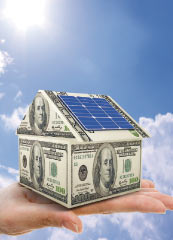
$2 Per Watt Rebate
This is a big deal. You can actually get a check from your utility company for several thousand of dollars to help you pay for your system. Let’s look at this using an example: If you install a 5kW system (5,000 watts) on your house, you will get a check from your utility company (Ameren, KCP&L, or Empire Electric) for $10,000. That’s pretty cool! How would you like to have your utility send YOU a check for a change?
And it gets better… The current regulatory rules say that the check must be sent within 30 days of application. Now, that’s service!
(For a more in-depth look at the Missouri rebate, see our Missouri Rebate page.)
30% Federal Tax Credit
This is a separate program at the federal level that your Uncle Sam has in place to reward you for being smart and making the move to clean, renewable energy. It’s included here because The Clean Energy Initiative to make a huge difference in the cost of a system. This program allows you to receive up to 30% of the cost of the system as a tax credit. What’s a tax credit…? It’s essentially a voucher that you can use to pay your taxes. When you file your taxes, you will have a credit to apply toward any tax liability you might have to the tune of 30% of the cost of your renewable energy system. Wind, biomass, solar electric, solar heat, solar hot water, and more! NOTE: this is a tax matter, so some understanding of tax code is required to maximize your benefit. Consult a tax professional if you have any question about how to best take advantage of this program.
Renewable Energy Credits
A renewable Energy Credit (REC) is like a birth certificate that’s issued every time a MegaWatt of renewable energy is generated. The biggest difference is that companies will buy them in order to show that they are encouraaging the generation of “green” energy to offset their emissions. Right now, the market for REC’s in Missouri is in its fledgling stages. You might even say it’s still in gestation since many of the rules are not even written yet–much less finalized and approved. But stay tuned! We’ll give you the latest news on REC’s as soon as it’s available!
“We are like tenant farmers chopping down the fence around our house for fuel when we should be using nature’s inexhaustible sources of energy. I’d put my money on the sun and solar energy. What a source of power! I hope we don’t have to wait until oil and coal run out before we tackle that.“
-Thomas Edison
Contact Us to find out how you can benefit from these great programs!
Here at Certified Solar Solutions, the management team makes a point of knowing what’s going on from the top to the bottom of our operation. There’s no better way to do that than to roll our sleeves up and get to work at what we love to do: install clean energy for all the right reasons.
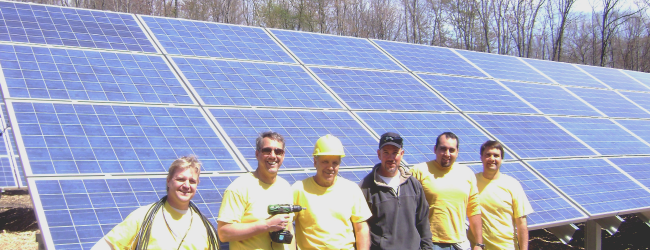
Solar technology is mature. Solar cells have been made for going on half a century now. Still, designing or installing a solar electric system is something no professional takes lightly. Solar hot water, wind, and ground-source heat pump systems are like that, too. There are more ways to design and install these systems wrong than there are right ways. That’s why it’s important to demand quality and professionalism in your renewable energy system supplier.
Why Certify?
That is an excellent question. There are three major factors in play when installing an energy system on your property:
- The safety of the workers (and you and your guests)
- The Performance of the system
- The condition of your roof after the job is done
Certification also shows that your renewable energy professional is serious about maintaining high standards within the industry. If you value quality work, seek out and hire a certified professional.
Certified Solar Solutions, LLC is one of only two renewable energy companies in Missouri with two NABCEP certified energy professionals on staff. NABCEP certification, issued by the North American Board of Certified Energy Practitioners, is the gold standard for solar PV, wind, and solar hot water energy systems. Many states that have renewable energy initiatives like Missouri does have found out the hard way that the only guarantee of success is to demand high standards of knowledge and professionalism from the practitioners in the industry.
Quality and professionalism is NABCEP’s mission–and that’s why we’re NABCEP certified.
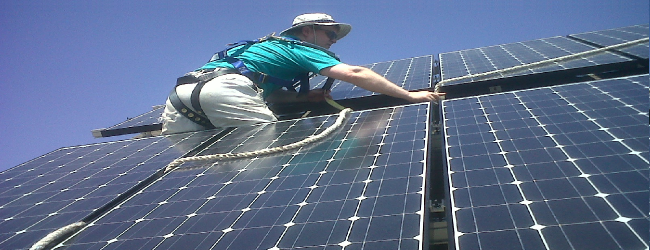
Safety
When anyone goes up onto a roof for any reason at all, they must be aware of the hazards and dangers present. When someone goes up onto a roof to work, they must be very familiar with the challenges of working on a roof. Besides falling off, it’s possible to drop something and have it go over the side. The less often that happens, the less likely someone on the ground will be injured.
At Certified Solar Solutions, safety really does come first. We run a safety checklist on every job and our installers and supervisors receive OSHA 10-hour training every year.
There are no degrees of safety. There is only safe and NOT safe. Safe workers feel more comfortable and are more productive. A single accident can ruin a company. If you see a contractor cutting corners on safety, know that they aren’t in business for the long haul. Safety harnesses and ropes, work platforms, and barricades should be in full use at all times.
Performance
When you buy a solar electric (photovoltaic) system or a solar hot water system, you’re counting on it to do its job for many years, and do it well. A well-designed system will be an asset that any homeowner would be proud to have and any certified professional would be proud to sign off on. Unfortunately, a proorly designed or poorly installed system is guaranteed to be a poor performer–and worse, will take much longer to pay for itself than it should. Perhaps never making it past the make-break point at all.
A NABCEP certified renewable energy professional has demonstrated knowledge and experience that allows them to predict system pitfalls and produce successful outcomes. They can maximize the output of a solar collector and save you a lot of money in utility bills.
Your best guarantee of a successful project is a certified professional installer and professional designer.
At Certified Solar Solutions, we employ degreed engineers and trained technicians and installers to make sure that quality and performance are at their peak. We’re the only renewable energy firm in Missouri with a licemsed Professional Engineer on staff. After a staff engineer reviews a design or project plan, our Professional Engineer goes through it thoroughly to ensure that nothing has been missed. We can even stamp your plans with a Professional Engineer’s seal, the highest mark of design quality there is.
Roof, Sweet Roof
Your roof is the most important part of your house. Water is the number one threat to your home. Once water comes in, mold, insects, and other undesirables soon follow. Therefore, choose a certified professional to perform the necessary modifications on your roof.
Here at Certified Solar Solutions, we inspect our customers’ roofs before the job, throughout the job, and at the end of the job. We are absolute roofing fanatics. In fact, we routinely repair roof problems that we find–often at no charge to our customer. Your roof is your insurance policy against water damage and major headaches down the road, and we take that very seriously.
Our Mission
The team of dedicated, certified professionals at Certified Solar Solutions wants nothing but peace of mind for you and meany years of low electric bills.
Contact Us to find out how our team of design and installation professionals can help you take control of your energy future.

Net metering applies to systems from zero to 100kW. That’s a big range and covers everything from small houses (or condos) to light manufacturing. 100kW will produce enough to power most large commercial businesses. If you need even more, though, we can deliver.
Certified Solar Solutions has the project management experience to handle multi-million-dollar projects. From contracts to site superintendents, we are also available to be your Owner’s Representative and ensure that your industrial-scale project exceeds your goals.
Contact Us to discuss your large-scale project.








